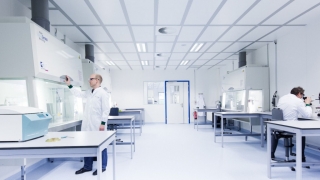InSciTe experiences growth spurt
Unique matrix concept bridges Valley of Death
Based at the Brightlands Chemelot campus, InSciTe (Institute for Science and Technology) supports scientists and starting businesses to translate medical innovations to practical applications, among other things. Three years after it was founded, the biomedical department of the institute has outgrown its location. Construction will start this year on new labs and cleanrooms.
Danielle Curfs is keeping her options open. The financing for a brand-new building with accompanying facilities is starting to take on a more well-defined shape, but the three interested investors have not put their signatures to the documents yet.
Dream
Although this is just a formality, it can’t be dismissed as unimportant. “It would be terrible if I were to talk out of turn and the project was then ultimately called off,” the manager of the InSciTe biomedical program says. “The matrix concept we are going to implement is something we have worked on for years. It’s a dream come true. It will allow us to get promising new treatments for diseases and disorders ready for the clinical testing phase. This is an expensive process that often fizzles out due to a lack of facilities, money and know-how. A terrible shame; after all, why else would you come up with innovations? Not to just end up having to shelve them, that’s for sure. Thanks to the biomedical matrix accelerator, we are able to offer a learning and working environment with the infrastructure, equipment, personnel and knowledge necessary to put a dissertation or business plan into practice.”
Practice
In 2015, Maastricht UMC+, the Technical University Eindhoven, DSM and the Province of Limburg put up 80 million Euros for the start and set-up of InSciTe. This was intended to translate innovations on paper into practical applications. “There are so many researchers with brilliant dissertations, so many starting businesses with ideas that get bogged down when it comes to the technical and quality implementation and the financing that goes along with this,” says Danielle Curfs, also a graduate of Maastricht University. “InSciTe was set up at the time to offer these entrepreneurs and researchers the learning and working environment they need to help them develop their own ideas.”
InSciTe focuses on converting concepts that have more or less been proven to industrial and medical applications. Danielle Curfs has concentrated on the biomedical side since the institute was founded. “There has been a lot of interest since the beginning, and we began working on different projects and startups straight away. So many candidates indicated their interest last year that we started seriously thinking about expansion.”
Independent
This expansion will, in all likelihood, become a reality now. Danielle Curfs adds, “We are going to set up an independent company with labs, cleanrooms and technical and quality-control specialists. These are all elements startups and researchers can rent based on their needs. The costs are affordable since facilities such as infrastructure, equipment, know-how and skills can be shared as much as possible. There is an overall quality management system, and the maintenance and calibration of the equipment is taken care of, which means a savings in valuable time and money as compared with a stand-alone option. InSciTe will become an important customer, during the initial years at any rate.”
Sharing knowledge
According to Danielle Curfs, the way the biomedical matrix accelerator works is unique. “Different projects being carried out in one space; this is unheard of. Entrepreneurs are rather wary about people looking over their shoulder or even espionage. This is a misplaced fear. Our clients come to us with inventions that have already been patented, so they are compatible. It goes beyond that though; they learn from one another and share knowledge. It’s a perfect example of open innovation. The institute bridges the gap between dissertation or business plan and potential applications. In professional jargon, it’s also referred to as the Valley of Death. This is where even the most promising innovations can perish. Not only do we offer a complete palette of facilities, we also pave the way for the next, crucial step: the clinical testing phase. This is why the relationships between the campus here in Geleen and the one in Maastricht are immensely valuable. The concepts originate in Maastricht and other locations, after which they enter the scaling-up phase here, and from there, Maastricht UMC+ takes over for the clinical tests.”
Production
There is one step left after this. “Once the invention has been technically and clinically validated, there is plenty of room here to set up production facilities. There is plenty of room at the campus, and thanks to the process the parties in the matrix have completed, they have a solid foundation of qualified personnel at their disposal. This is good for employment and the further development of the Brightlands Campuses. And with that, the entire ecosystem is complete.”
Concrete
Are there any concrete examples available? “Definitely,” says Danielle Curfs with a smile. “The finishing touches are currently being put on an implant which will allow for measured doses of medicine to be administered to patients’ eyes. There are also two parallel developments taking place to create new blood vessels for dialysis patients and a stem-cell therapy to treat paraplegia. We are currently working on seven of our own projects and four small companies have moved into our facility. There is a waiting list now for startups that also want to take advantage of our matrix accelerator. I can’t wait until we can also provide housing for these parties and continue to help them.”
Watch here the video 'The Dutch Life Sciences & Health regions in the spotlight' featuring InSciTe:

